Duck Housing and Management
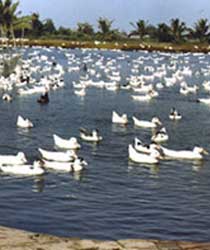 The Small Home Flock
The Small Home Flock
In areas where poultry raising is allowed and space is available, a small flock of ducks can be kept in the yard of a household at a low cost. Except for a brooder, which is needed for the first week or so, the main facilities and equipment needed to get started are a simple structure, such as a partially-enclosed shed, inexpensive fencing, a feed hopper or trough made of wood and a simply constructed watering device. The shelter should be located on a high, well-drained area of the yard. Whenever available, sandy soil is preferable for the duck yard because it drains quickly after a rain. The earth floor of the sheltered area should be bedded with straw, shavings or similarly dry absorbent material. Low fencing (about 61cm) is satisfactory for Pekins, since they do not fly, but not for Muscovies, which are adept to becoming airborne. If predators are a problem at night, the open areas of the shed and pen may have to be covered with inexpensive netting or wire mesh.
Raising Ducks on Open Ponds
Ducks may be kept successfully on open ponds, provided a nearby dry sheltered area is available. Ducks kept on ponds may obtain part of their food from plant and animal life in and around the pond, but supplemental feeding will probably be necessary. In tropical areas it is common to combine duck raising on ponds with fish farming. Ponds are stocked with fish such as Tilapia which are raised for human food. Manure from the ducks provide nutrients for growth of animal and plant life which the fish consume. The number of ducks kept on ponds must be limited to prevent an over-supply of nutrients and overgrowth of plant life which will cause depletion of oxygen in the water and kill the fish. Usually both the ducks and fish are given supplemental feed, which on commercial duck/fish farms is often a nutritionally complete pelleted ration.
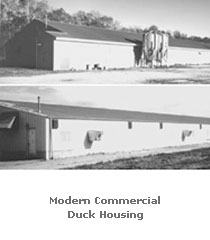 Herding Duck Management
Herding Duck Management
In Indonesia, herded flocks under the care of a single herdsman usually range in size from 90 to 130. During the day, a flock of ducks, usually mature females, is allowed to search for food in harvested rice fields and other areas where food is plentiful. At night, the flock is returned to a confinement, usually a bamboo pen, where eggs are laid during the night. Eggs are collected and sold, or used for food by the herdsman's family. The major part of the diet of herded ducks consists of whole grains and snails, plus small amounts of insects, leaf material, crabs and frogs. It is the job of the herdsman to move the flock, as often as necessary, to areas where food is plentiful. Portable fencing and other equipment is moved with the flock to each new location. A grassy area with some protection, such as provided by trees, is selected as a base camp where the fencing is set up. Supplemental feed is given to herded ducks only when the food supply in the fields is inadequate. See also Ducks for Herding.
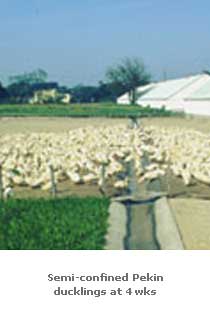 Commercial Duck Production
Commercial Duck Production
A thorough discussion of modern commercial duck production is beyond the scope of this web page. More in depth sources of information can be found in Publications. Commercial duck housing is usually one of two types: total confinement and semi-confinement. Modern commercial total-confinement duck housing usually has clear-span-truss framing, and is well insulated and mechanically ventilated. Age groups are kept isolated, either in separate buildings or in separate rooms with solid partitions between them. Floor design is usually one of two types: all wire mesh; or a combination of litter and wire mesh with waterers located on the wire.
Ventilation systems are usually the negative pressure type with adjustable, or automatically controlled air inlets and exhaust fans located along the side walls. Because waterfowl drink and excrete more water than land fowl, extra demand is placed on the ventilation and heating system to remove the extra moisture and maintain proper temperatures. The advice of an agricultural engineer, who is familiar with duck housing, is very helpful when designing buildings. When properly designed and managed, modern duck housing provides ducks a high degree of protection from the detrimental effects of extremes in weather and entry of duck diseases.
The ability to exclude wild birds from buildings is alone a large factor in preventing the introduction and spread of diseases. In addition to allowing year-round production and marketing at an earlier age, benefits include improved feed conversion and more predictable, and usually better weight gain. Semi-confinement duck housing is similar to the above in many respects with the exception that ducks over 2-3 weeks of age are allowed outdoors during the day. Ducks over 4 weeks of age may spend much of their time outdoors with minimal use of shelter.
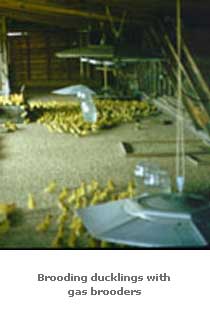 Brooding
Brooding
Much of the information on brooding chicks, available in poultry textbooks and other sources (see Publications), can be applied to ducklings. If ducklings are hatched artificially, rather than by a broody duck, the caretaker must provide the newly hatched ducklings with a warm dry brooding area free of drafts, with a source of heat, such as radiant or hover-type gas brooders, and feed and drinking water located near the heat source so that the ducklings learn to drink and eat soon after they are placed in the brooder. If ducklings haven't learn to drink within a few hours, it may be necessary to dip their bills in the drinking water in order to coax them to start drinking. In the case of earth or cement floors, the brooding area should be bedded with clean dry litter such as wood shavings or chopped straw.
If drafts are a problem, newspapers may be put down on wire floors for the first few days. Use brooder guards to keep the ducklings confined to the area where the heat, water and feed are located. The brooder guards should allow enough room so that the ducklings can move away from the heat if it gets too warm. See Table 1 for recommended temperatures, which are gradually lowered as the duckling grows. In addition, ducklings should be allowed access to more of the floor area of the pen as they grow older. When outside temperatures are above 70°F (21.1°C), ducklings can be allowed outdoors part of the day after about 14 days of age.
Optimum Temperatures for Ducks
At the time of hatching, ducklings require a high temperature of about 86°F (30°C). They are not yet able to regulate their body temperature and must have supplemental heat such as that provided by a brooder. As they grow older they become better able to produce and conserve heat, and regulate their body temperature. After a duckling is fully covered with feathers and down, they are able to maintain proper body temperature even when the outside temperature is low. The recommended temperatures for ducks at different ages are given in Table 1.
Table 1: Optimum Temperatures for Ducks
| Age in Days | ºF | ºC |
|---|---|---|
| 1 | 86 | 30 |
| 7 | 81 | 27 |
| 14 | 73 | 23 |
| 21 | 66 | 19 |
| 28 | 59 | 15 |
| 35 | 55 | 13 |
| 42 | 55 | 13 |
| 49 | 55 | 13 |
| Developing breeders | 55 | 13 |
| Laying breeders | 55 | 13 |
Floor Space
Overcrowding ducks can be extremely detrimental to their health, growth or egg production. Providing adequate floor space at each stage of development is basic to successful duck raising. While under crowding is not usually a problem, it is better to stock ducks at near the recommended density (see Table 2 below) in cold weather so that body heat will help warm the room in which the ducks are confined.
Table 2: Floor Space Allowances for Ducks
| Age in Days | Space/Duck (sq cm) | Space/Duck (sq ft) |
|---|---|---|
| 1 | 289 | 0.31 |
| 2 | 576 | 0.62 |
| 3 | 1024 | 1.10 |
| 4 | 1369 | 1.47 |
| 5 | 1764 | 1.90 |
| 6 | 2116 | 2.28 |
| 7 | 2304 | 2.48 |
| Developing breeders | 2500 | 2.69 |
| Laying breeders | 2809 | 3.02 |
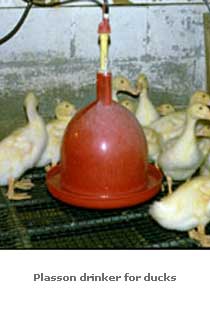 Flooring for Ducks
Flooring for Ducks
Duck keepers should avoid flooring that will injure the skin covering the feet and hock joints of ducks. The smooth skin of ducks is not as tough (not as cornified) as that of land fowl, and is more susceptible to injury when ducks are confined on surfaces that are too rough, or abrasive. Slats, wire floors or cage bottoms may cause injury to the feet and legs of ducks, unless these surfaces are smooth, non-abrasive, and free of sharp edges. Stones, mixed with the soil covering the duck yards can also cause injury.
The detrimental effect of flooring on ducks increases with the age and size of the duck, and the longer ducks are confined to the flooring. The likelihood of injury is greatly reduced if wire occupies no more one-fourth to one-third of the floor area. Properly constructed wire floors are usually a better choice than slats, which can cause leg deformities as well as injury to skin. If wire floors are used, floors for ducklings under 3 weeks should be constructed of 1.9 cm (3/4 inch) mesh, 12-gauge welded wire, attached to a frame designed to keep the wire flat, and minimize manure accumulation. For ducks over 3 weeks, 2.5 cm (1 inch) mesh is best. Vinyl coated wire is preferable, but smooth galvanized wire is satisfactory.
Management of Litter and Yards
Ducks drink and excrete more water than chickens or turkeys. Their droppings contain over 90% moisture. It is therefore necessary to take extra measures to maintain litter floors inside sheltered areas in a dry condition. This will require regular addition of fresh bedding, on top of the bedding that has become soiled or wet, and when necessary, cleaning out the old litter and replacing it with fresh litter. Under semi-confinement growing, in which case ducklings spend most of their time outdoors during the day (after the first 3 weeks), waterers should be located outside, as far away from the house as possible. This will reducing tracking water to the litter. During periods when temperatures drop below freezing, water must be provided indoors. Duck yards should be maintained in a clean condition by removing the upper few inches of soil and replacing it with clean soil (preferably sand) whenever necessary.
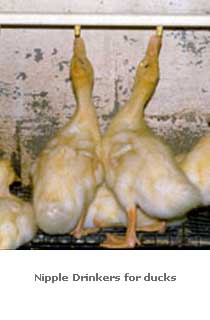 Feeders and Feeding Space
Feeders and Feeding Space
Most feeders used for other poultry, are satisfactory for ducks, provided sufficient room is allowed for the larger bill of ducks and their "shoveling" eating motion. If ducks are hand fed, simple trough feeders work fine. If feed hoppers are used, they should be constructed so that feed will slide down freely into the bottom of the hopper as feed is consumed. Providing an apron in front of the feeding area, for catching feed that is dropped or billed out, will reduce feed wastage.
During their early stages of growth, ducklings eat frequently, much like chickens. As they grow older they are able to store increasing amounts of feed in their esophagus at each feeding, and thus need to eat less frequently. By about four weeks of age, Pekin ducks can easily consume 100 grams or more of pellets at a single feeding. It is important to provide about 1 inch (2.5 cm) of feeder space per duck for about the first 3 weeks. Afterwards this can be gradually reduced to about half this amount so long as there is no crowding at the feed hoppers. Developing breeders that are being fed an allotted amount of feed each day should be allowed plenty of feeding space so that all birds can eat at once, which requires about 4 inches (10 cm) of linear space per duck.
Waterers for Ducks
Waterers designed for chickens and turkeys are usually satisfactory for ducks, as long as the size of the duck's bill is considered. Trough, can or jar-type waterers can be used so long as the drinking area is wide enough (at least 4 cm) for the duck to submerge its bill. The same requirement applies to automatic trough, cup or Plasson waterers. Nipple waterers, if properly adjusted for the duck's height, are also satisfactory.
If waterers are located indoors where the floor is bedded with litter, waterers should be located on a wire-mesh screen to reduce wetting of the litter. In commercial duck houses it is usually advisable to construct a cement floor drain underneath the water screens. For starting and growing ducks, provide a minimum of about 1 inch (2.5 cm) of linear watering space per duck. Increase this to 2 inches (5.0 cm) per duck for developing and laying breeders. If nipple waterers are used, provide 15 nipples per 100 ducks for starting and growing ducks and 20 nipples/100 ducks for developing and laying breeders. Starting ducklings should always have access to watering cans, jars or troughs until they have learned to drink from nipple waterers. See also Water.
Ventilation
Duck houses or shelters for small flocks usually do not require mechanical ventilation as used in modern commercial duck buildings. However some ventilation is always necessary when ducks are kept in a house enclosed on all sides. Window openings, and ridge ventilation may provide adequate air exchange. If larger flocks are kept in totally enclosed houses, the use of ventilation fans may be necessary. Proper ventilation of commercial duck buildings requires the expertise of an agricultural engineer or someone with knowledge and experience in designing and ventilating poultry buildings.
Modern duck buildings must be adequately insulated for ventilations systems to work properly. Ventilation systems for ducks should deliver a minimum of 0.2 cfm/lb duck weight at .05 inches (water gauge) static pressure and a maximum ventilation rate (when temperatures are above the desired point) of 0.8 cfm/lb duck weight at .02 inches static pressure.
Lighting
The length of the laying period of ducks can be increased considerably if supplemental lighting is provided. If supplemental light is not provided, egg production will be seasonal and dependent on changes in natural day length. Adding artificial light to extend the daily light period to 14-17 hours, and preventing any decrease in day length, will provide adequate light stimulation for ducks to lay continuously for 7-12 months, depending upon their ability to lay, and other conditions. If ducks are confined to a building at night and allowed outdoors during the day (or if confined to non-lightproof housing), the usual practice is to turn artificial lights on at a set time before sunrise, off at a set time after sunrise, then on again before sunset and off after sunset, maintaining a constant light period (14 hours, for example) and a constant dark period (10 hours in this case) each day. Such a lighting regimen is usually implemented with the aid of electric time clocks that turn lights on and off at set times.
A light intensity of about 10 lux (1 foot candle) at the duck's eye level is sufficient to stimulate adequate sexual response in both drakes and ducks. In practice, however, breeding and laying ducks are commonly lit to provide 20-30 lux at duck level. Artificial lighting is less important for growing ducks. Ducks are nocturnal, and can find feed and water in the dark. However artificial light is important the first few days to assist ducklings in getting started drinking and eating. Totally confined ducks being grown-out for marketing, as in commercial production, are usually provided some light every day. It is also beneficial to provide dim light by means of low wattage bulbs during dark periods to help prevent stampeding if the flock is disturbed and to discourage feather pecking.
During the development period of breeder-layer ducks, it is desirable to avoid either increases or decreases in day-length as much as possible. A recent publication entitled Poultry Lighting by UK scientist Dr. Peter Lewis and Dr. Trevor Morris (see Publications on Ducks and Related Publications) reviews research demonstrating excellent laying performance of Pekin ducks given a constant light regimen of 17 hours/day throughout rearing and laying. It is recommended that this resource be consulted for more information on lighting ducks.


